Austro-Hungarian State Railways
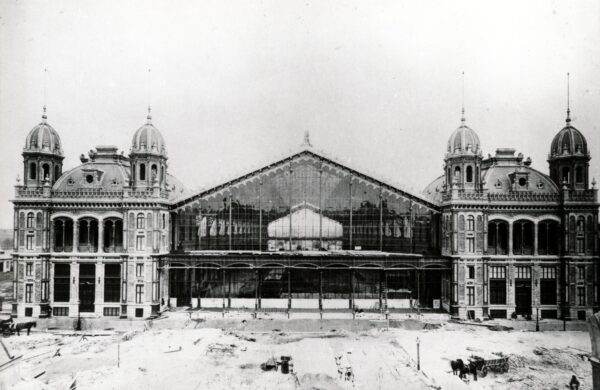
The Austro-Hungarian state railway was created in 1855, but not without precedent. Its predecessor was the Austrian Cs. Northern State Railways and the Austro-Hungarian State Railways. The first Hungarian steam railway company, the Hungarian Intermediate Railway, was established in 1850. These companies were nationalised by the Austrian state in 1850, and the empire's railway network was conceived as a state railway system.
By 1854 the Austrian state railway system had failed economically, and the state sold off the existing lines, the sections under construction and the licences. Thus, the later Austrian State Railways network was acquired by a group of French and Austrian capitalists, represented by George Sina, Daniel Eskeles, Isaac Pereire and Rafael Galliera. The network included the Vienna-Pest and Pest-Seged lines in Hungary and the Austrian sections to Vienna-Brno and Olomouc, and the company was also granted a licence for the Szeged-Temesvár line and the line from Timisoara to the Danube, branching off from the existing Lissava Bazias line. The new company also took over the management of the Lissava-Oravica-Bazias railway, which had already been built, as well as the Vienna-Győr line. The takeover price was around HUF 77 million, but the company received an annuity of HUF 5.2% from the state on the purchase price. The redemption price had to be paid in 36 monthly instalments. Between 1858 and 1864, the Royal Austrian State Railways Company issued bonds totalling 200 million francs to secure the capital and the necessary investments.
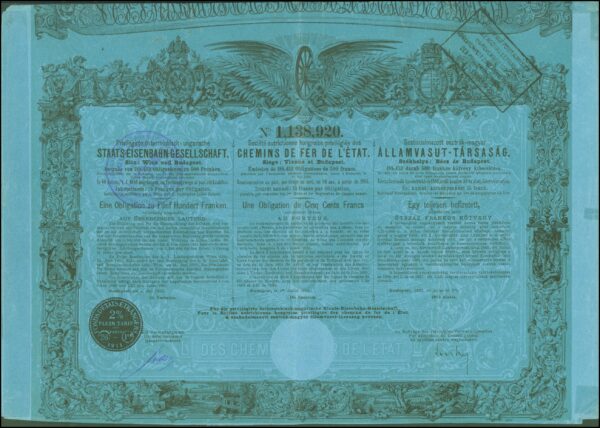
The construction of new sections was started immediately, and those already under construction were completed, so that the section from Timisoara to the Danube was completed by 1858, and the Austrian State Railway Company had a continuous railway network from the western border of Bohemia - with several branch lines in Austrian territory - through Budapest and Szeged in Hungary to Orsová. They also included the Vienna-Ujszőny-Komárom line, and a section from Galanta to Zsolná, a network of 1,350 kilometres in Austria and 1,500 kilometres in Hungary.
If you look at the Hungarian railway network of the time, you can see that the State Railway Company owned and operated the most important railway lines in Hungary, i.e. the lines to Vienna, and the lines through the Great Plain to Szeged, Southern Transylvania and Banat, i.e. the main routes from the main grain-producing areas to Western Europe.
In 1857, the company built the Tisza railway bridge in Szeged, using methods previously unknown in Hungarian bridge building, making it the first bridge based on the keszon, or overpressure method, and the first metal structure in Hungary to be riveted together. The company continued to open new lines in the 1870s, and in the early 1880s converted several of its lines, such as the Pest-Vienna line, to double track.
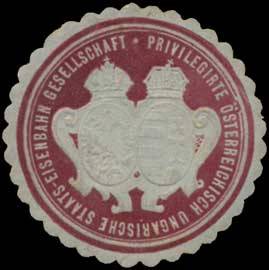
In 1882, the Hungarian state and the company concluded a comprehensive contract, under which they swapped the Győr-Ujszőny railway with MÁV, in exchange for the Vienna-Bruck-Királyhida-Győr, Bratislava-Récse-Nagyszombat-Vágújhely-Trencsén, Nagyszombat-Szered and Récse-Prácsa lines. For MÁV, this was important because the construction of the missing Buda-Ujszőny line between Budapest and the western border of the country would allow the line to run under MÁV's jurisdiction along the right bank. It was also part of the contract that the company would change its name, so from 1883 it was known as the Austrian-Hungarian State Railways Company. It was also stipulated in this contract that the Hungarian lines of the company could be purchased by the state at any time after 1 January 1895.
However, the Hungarian state did not wait for the 1895 deadline because of Gábor Baross's nationalisation policy, as the private railways, which owned the country's most important lines, were one of the biggest obstacles to the unified state railway concept. In 1891, the state therefore redeemed the railway, the redemption amount being fixed by contract at an annuity of 10,665,000 Austrian forints per year for seventy-five years. This meant that the largest private railway network was taken over by MÁV
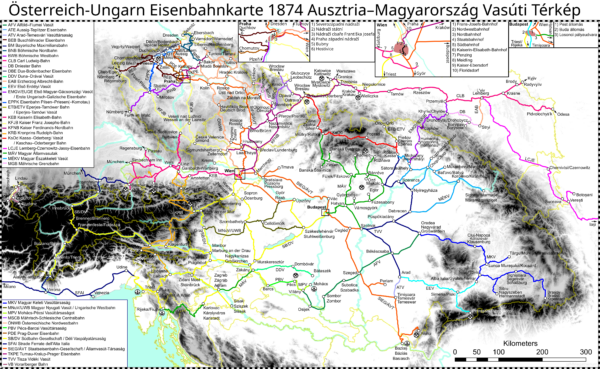
Points of interest
A comprehensive agreement on the construction of the new Austrian State Railways station in Pest has been reached, which has clarified many of the disputes between the railway company and Budapest. When the railway station was built in the northern part of Pest in 1846, the area was undeveloped, but by 1874 this had changed, and the planned Great Ring Road even affected, or rather cut in half, the old station building. Therefore, in 1873, as part of a comprehensive agreement, the company undertook to build a new station building on the site of the old one, but slightly to the north of it, and to demolish the existing station. Although new office buildings were built at the southern end of the old station, in what was then Gyár Street, shortly before the agreement was concluded, at a cost of 350,000 forints, the solution was to demolish the old station, but to retain the newly built houses, which were placed on the southern side of the new Nagykörút.
The new station building itself, whose hall originally accommodated 6 tracks and was the largest railway station building in the Monarchy at the time, was built for 8 million forints in 1877. The construction was not easy either, as the new building was built over the old hall, which had been erected in 1846 and was only demolished after the new one was completed.
The pedestrian underpass, long demanded by the Teréz and Angyalföld citizens, was built in 1874 as part of the project, as well as the predecessor of today's Ferdinand Bridge.
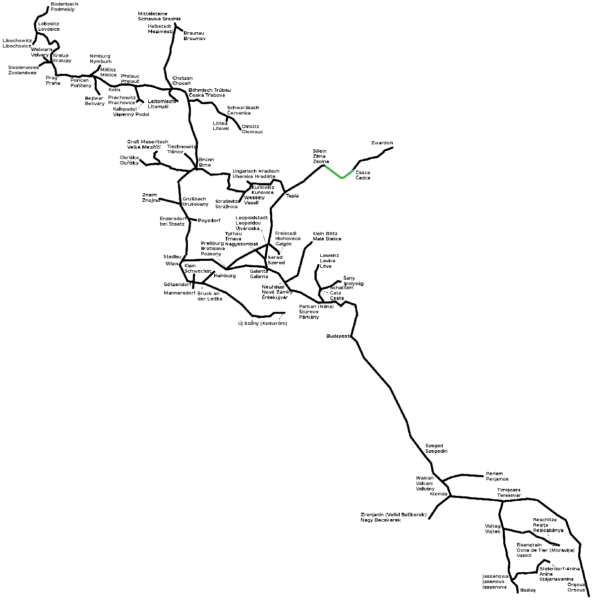
Sources
- István Tisza: The development of the Hungarian and state and private railway companies between 1847 and 1875 In.
- László Vörös (ed.): Hungarian Railway Yearbook 1 year 1878 (Budapest, 1878)
- László Vörös (ed.): Hungarian Railway Yearbook Vol. 5 / 1882 (Budapest, 1883)
- Act XXXVIII of 1891 approving and enacting the contract concluded on 7 June/11 July 1891 on the basis of Article XXV of Act XXV of 1891 for the redemption of the Hungarian railway lines of the Austrian-Hungarian State Railway Company
Date of foundation: 1855
Date of cessation: 1920
Founders: György Sina, Daniel Eskeles, Isaac Pereire and Rafael Galliera
Securities issued:
| Austro-Hungarian State Railways |
| Austrian-Hungarian State Railways Futures |
Decisive leaders:
1855-1856 | George Sina |
1855-1885 | Baron Mór Wodianer |
Main activity: railway operation, railway construction
Author: by Domonkos Csaba
Date of foundation: 1855
Founders: György Sina, Daniel Eskeles, Isaac Pereire and Rafael Galliera
Decisive leaders:
1855-1856 | George Sina |
1855-1885 | Baron Mór Wodianer |
Main activity: railway operation, railway construction
Main products are not set
Seats are not configured
Locations are not set
Main milestones are not set
Author: by Domonkos Csaba
Austro-Hungarian State Railways

The Austro-Hungarian state railway was created in 1855, but not without precedent. Its predecessor was the Austrian Cs. Northern State Railways and the Austro-Hungarian State Railways. The first Hungarian steam railway company, the Hungarian Intermediate Railway, was established in 1850. These companies were nationalised by the Austrian state in 1850, and the empire's railway network was conceived as a state railway system.
By 1854 the Austrian state railway system had failed economically, and the state sold off the existing lines, the sections under construction and the licences. Thus, the later Austrian State Railways network was acquired by a group of French and Austrian capitalists, represented by George Sina, Daniel Eskeles, Isaac Pereire and Rafael Galliera. The network included the Vienna-Pest and Pest-Seged lines in Hungary and the Austrian sections to Vienna-Brno and Olomouc, and the company was also granted a licence for the Szeged-Temesvár line and the line from Timisoara to the Danube, branching off from the existing Lissava Bazias line. The new company also took over the management of the Lissava-Oravica-Bazias railway, which had already been built, as well as the Vienna-Győr line. The takeover price was around HUF 77 million, but the company received an annuity of HUF 5.2% from the state on the purchase price. The redemption price had to be paid in 36 monthly instalments. Between 1858 and 1864, the Royal Austrian State Railways Company issued bonds totalling 200 million francs to secure the capital and the necessary investments.

The construction of new sections was started immediately, and those already under construction were completed, so that the section from Timisoara to the Danube was completed by 1858, and the Austrian State Railway Company had a continuous railway network from the western border of Bohemia - with several branch lines in Austrian territory - through Budapest and Szeged in Hungary to Orsová. They also included the Vienna-Ujszőny-Komárom line, and a section from Galanta to Zsolná, a network of 1,350 kilometres in Austria and 1,500 kilometres in Hungary.
If you look at the Hungarian railway network of the time, you can see that the State Railway Company owned and operated the most important railway lines in Hungary, i.e. the lines to Vienna, and the lines through the Great Plain to Szeged, Southern Transylvania and Banat, i.e. the main routes from the main grain-producing areas to Western Europe.
In 1857, the company built the Tisza railway bridge in Szeged, using methods previously unknown in Hungarian bridge building, making it the first bridge based on the keszon, or overpressure method, and the first metal structure in Hungary to be riveted together. The company continued to open new lines in the 1870s, and in the early 1880s converted several of its lines, such as the Pest-Vienna line, to double track.

In 1882, the Hungarian state and the company concluded a comprehensive contract, under which they swapped the Győr-Ujszőny railway with MÁV, in exchange for the Vienna-Bruck-Királyhida-Győr, Bratislava-Récse-Nagyszombat-Vágújhely-Trencsén, Nagyszombat-Szered and Récse-Prácsa lines. For MÁV, this was important because the construction of the missing Buda-Ujszőny line between Budapest and the western border of the country would allow the line to run under MÁV's jurisdiction along the right bank. It was also part of the contract that the company would change its name, so from 1883 it was known as the Austrian-Hungarian State Railways Company. It was also stipulated in this contract that the Hungarian lines of the company could be purchased by the state at any time after 1 January 1895.
However, the Hungarian state did not wait for the 1895 deadline because of Gábor Baross's nationalisation policy, as the private railways, which owned the country's most important lines, were one of the biggest obstacles to the unified state railway concept. In 1891, the state therefore redeemed the railway, the redemption amount being fixed by contract at an annuity of 10,665,000 Austrian forints per year for seventy-five years. This meant that the largest private railway network was taken over by MÁV

Points of interest
A comprehensive agreement on the construction of the new Austrian State Railways station in Pest has been reached, which has clarified many of the disputes between the railway company and Budapest. When the railway station was built in the northern part of Pest in 1846, the area was undeveloped, but by 1874 this had changed, and the planned Great Ring Road even affected, or rather cut in half, the old station building. Therefore, in 1873, as part of a comprehensive agreement, the company undertook to build a new station building on the site of the old one, but slightly to the north of it, and to demolish the existing station. Although new office buildings were built at the southern end of the old station, in what was then Gyár Street, shortly before the agreement was concluded, at a cost of 350,000 forints, the solution was to demolish the old station, but to retain the newly built houses, which were placed on the southern side of the new Nagykörút.
The new station building itself, whose hall originally accommodated 6 tracks and was the largest railway station building in the Monarchy at the time, was built for 8 million forints in 1877. The construction was not easy either, as the new building was built over the old hall, which had been erected in 1846 and was only demolished after the new one was completed.
The pedestrian underpass, long demanded by the Teréz and Angyalföld citizens, was built in 1874 as part of the project, as well as the predecessor of today's Ferdinand Bridge.

Sources
- István Tisza: The development of the Hungarian and state and private railway companies between 1847 and 1875 In.
- László Vörös (ed.): Hungarian Railway Yearbook 1 year 1878 (Budapest, 1878)
- László Vörös (ed.): Hungarian Railway Yearbook Vol. 5 / 1882 (Budapest, 1883)
- Act XXXVIII of 1891 approving and enacting the contract concluded on 7 June/11 July 1891 on the basis of Article XXV of Act XXV of 1891 for the redemption of the Hungarian railway lines of the Austrian-Hungarian State Railway Company